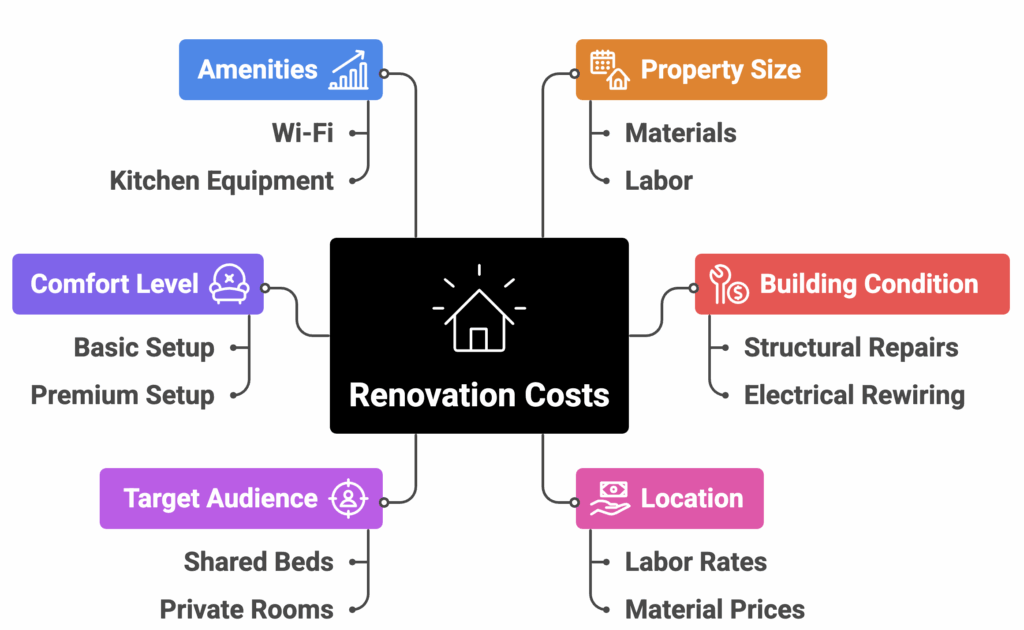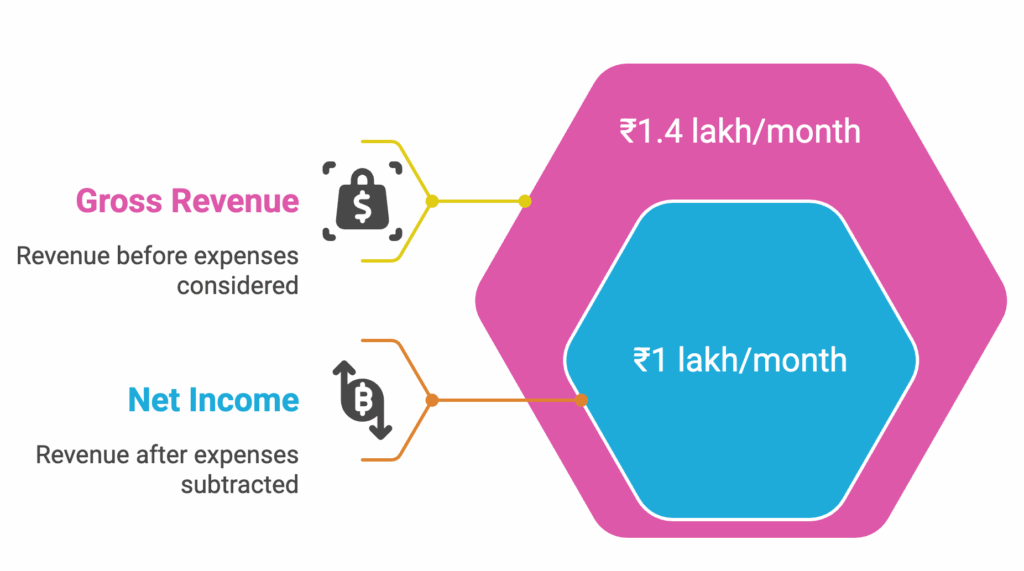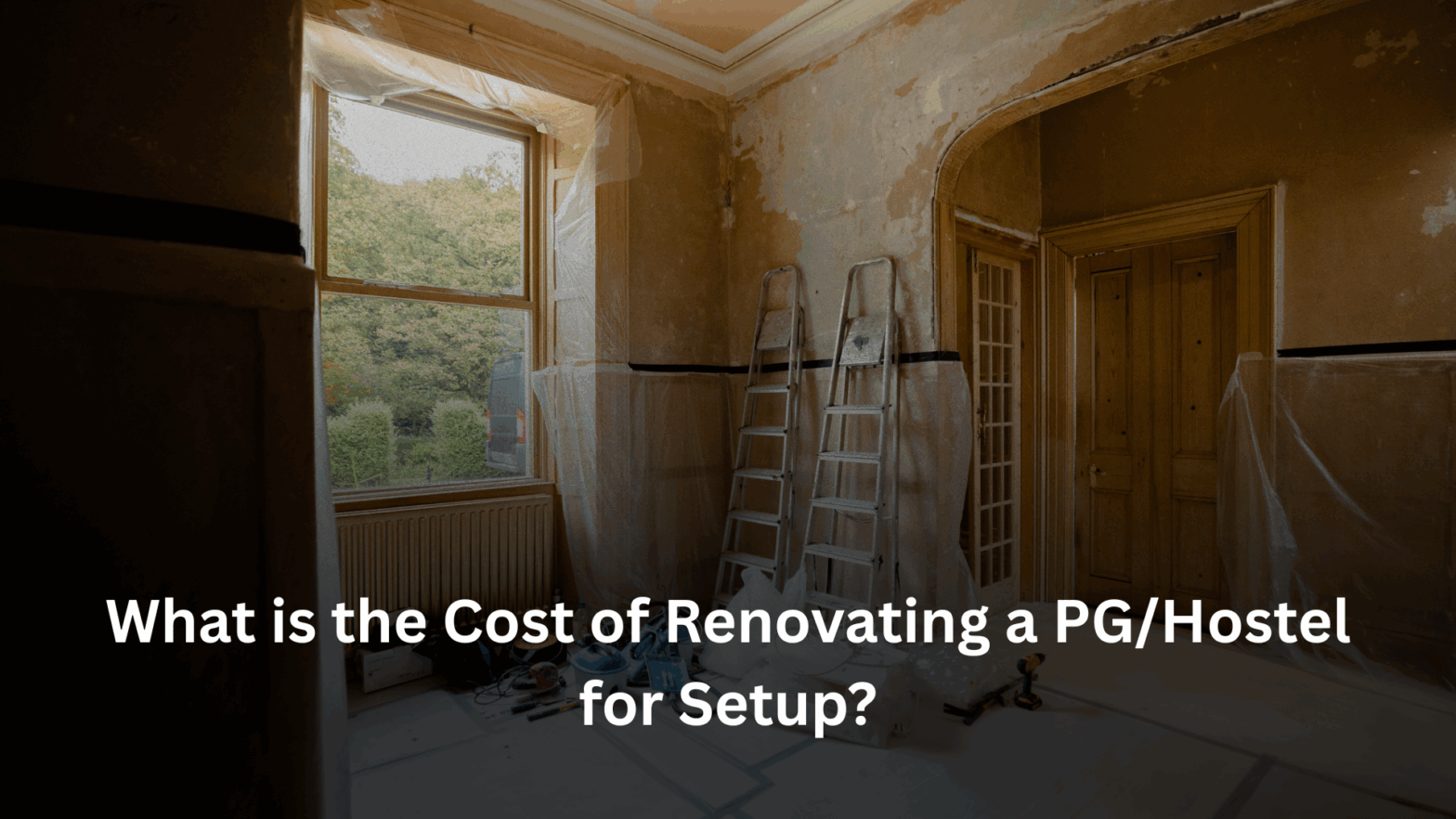What is the Cost of Renovating a PG/Hostel for Setup?
Starting a paying guest (PG) or hostel business in India can be a profitable venture but only if you get the basics right. Before you welcome your first tenant, your property needs to be renovated and customized for shared living.
And here’s the truth: most new PG owners either overspend on renovation or cut corners in the wrong places both of which kill profitability.
According to you property how much should you actually budget ? What are the factors that push the cost up or down? And where can you save money without sacrificing tenant comfort? Let’s break it all down.
Why Renovation Matters in PG/Hostel Setup
A PG/hostel is not just a regular house. You’re preparing a high-traffic, shared living space which means:
- Shared living optimization → space management for multiple tenants.
- Durable materials → because wear & tear is much higher than in a normal flat.
- Safety features → CCTV, fire safety, secure entry points.
- Tenant experience → good interiors, lighting, and furniture that attract higher-paying renters.
A well-renovated property isn’t just “nice to have” it directly impacts:
- Rental rates you can charge
- Occupancy levels (lower vacancy = steady income)
- Long-term maintenance costs
What are the Factors That Influence Renovating Costs?

| Factor | How It Impacts Costs |
| Property Size | Bigger property = more rooms, furniture, bathrooms. |
| Building Condition | Older buildings may need structural repairs (cracks, waterproofing, rewiring). |
| Location | Metro cities → higher labor + material costs. |
| Target Audience | Students → more shared beds, affordable setup. Professionals → private/semi-private rooms, premium finishes. |
| Comfort Level | Budget (basic interiors) vs Premium (AC, attached bathrooms, modern décor). |
| Amenities | Wi-Fi, AC, kitchen equipment, laundry machines, etc. |
What is a Realistic Cost Breakdown for a 20-Bed PG/Hostel?

Here’s a ballpark estimate for a mid-range 20-bed PG setup in India:
| Category | Description | Estimated Cost (₹) |
| Structural Repairs | Fixing cracks, waterproofing, flooring repairs | 1,50,000 – 3,00,000 |
| Painting & Wall Finishing | Interior & exterior paint | 80,000 – 1,50,000 |
| Electrical Work | Wiring, plug points, lighting | 1,00,000 – 2,00,000 |
| Plumbing & Bathrooms | Toilets, showers, tanks | 1,50,000 – 3,00,000 |
| Furniture & Storage | Beds, wardrobes, tables, chairs | 3,00,000 – 5,00,000 |
| Kitchen Setup | Stove, fridge, water purifier, utensils | 80,000 – 1,50,000 |
| Safety & Security | CCTV, fire extinguishers, exits | 50,000 – 1,00,000 |
| Miscellaneous | Décor, signage, registration fees | 50,000 – 1,00,000 |
Important Considerations:
- Premium Hostels: For premium hostels with amenities like air conditioning, attached washrooms, and upscale interiors, the costs can easily exceed ₹25 lakh.
- Contingency: It’s crucial to include a contingency fund (approximately 10-15% of the total estimated cost) to cover unforeseen expenses or unexpected repairs.
- Local Market Research: Conduct thorough research on local labor and material costs to obtain more accurate estimates.
- Negotiation: Negotiate prices with contractors and suppliers to potentially reduce overall costs.
- Phased Approach: Consider a phased renovation approach, prioritizing essential repairs and upgrades initially and adding more amenities later as budget allows.
By carefully considering these factors and conducting thorough planning, you can effectively manage renovation costs and create a successful PG/hostel setup.
💡 Total Range: ₹9 lakh – ₹18 lakh for a mid-range 20-bed PG.
For premium hostels with AC, attached washrooms, and upscale interiors, costs can easily cross ₹25 lakh.
How Quickly Can You Recover This Investment-ROI?
Let’s connect renovation cost to returns because this is something that will matter most:
Case Example:
– 20 beds @ ₹7,000/month average rent = ₹1.4 lakh/month gross revenue.
– Subtract utilities, salaries, and expenses (~₹40k/month).
– Net = ₹1 lakh/month.
– Payback period for ₹12 lakh renovation = 12 months.

This is why smart renovating but in a plannned way is crucial as overinvesting delays payback, underinvesting keeps your rents low.
How to Renovate Smartly?
Step 1: Define Your Market
• Students → shared rooms, sturdy furniture, study desks.
• Professionals → private/semi-private rooms, better interiors, Wi-Fi, AC.
Step 2: Prioritize High-Impact Areas
- Comfortable beds & mattresses (tenant satisfaction = retention).
- Clean, functional bathrooms (biggest complaint area).
- Security systems (parents of students value this).
Step 3: Plan for Ongoing Maintenance
• High-traffic properties will need repainting, plumbing fixes, and furniture repairs every 12–18 months. Budget for it.
Where to Save Cost while Renovating ?
Renovation doesn’t always mean spending lavishly. Many PG/hostel owners burn money on areas that don’t impact tenant comfort or retention. The trick is to spend smart not less. Here’s how you can cut costs wisely:
Buy in Bulk
Beds, mattresses, and paint are your biggest recurring needs. Buying them in bulk directly from wholesalers or manufacturers can reduce costs by 15–30%.
- Example: A single bed frame may cost ₹7,000 in retail, but bulk orders (10–20 units) can bring it down to ₹5,500 each.
- Same goes for paint, mattresses, and basic furniture — vendors are more open to discounts when the order size is bigger.
👉 Pro Tip: Team up with another PG/hostel owner in your area and place combined orders to unlock higher wholesale pricing.
Refurbish Instead of Replace
Not everything needs to be brand new. Many existing fixtures (wardrobes, cupboards, tables, doors) can be polished, repainted, or laminated instead of replaced.
- Example: Repainting a steel cupboard costs ₹1,500–2,000, whereas buying a new one can cost ₹8,000–10,000.
- Wooden furniture can often be sanded and polished to look new at one-third the cost.
👉 Pro Tip: For student-focused PGs, functionality matters more than luxury. If it works and looks decent, tenants won’t mind refurbished furniture.
Use Modular Furniture
Modular beds, wardrobes, and tables are easier to rearrange when you want to convert spaces from double-sharing to triple-sharing or vice versa. While modular furniture might look slightly costlier upfront, it saves money in the long run.
- Example: Instead of buying fixed cots, modular bunk beds allow you to add/remove tiers depending on demand.
- Flexible wardrobes and partitions let you redesign spaces without expensive carpentry each time.
👉 Pro Tip: For growing PGs, modular furniture prevents future re-renovation costs when tenant demand changes.
Go Energy-Efficient
Running costs matter as much as renovation costs. Choosing energy-efficient appliances reduces your monthly electricity bills significantly.
- Example: A 5-star rated ceiling fan consumes ~45% less electricity than a standard fan. Multiply this across 20–30 fans, and your annual savings run into thousands.
- LED lighting, inverter-based ACs, and water-saving taps all reduce recurring utility expenses.
👉 Pro Tip: Market this as a USP to attract tenants — “eco-friendly, lower power cuts, stable bills.” Parents especially appreciate hostels that use energy-efficient solutions.
How to Manage Your Pg/Hostel After Renovating?
But Renovating is only half the journey. The real test is running your PG smoothly once tenants move in.
This is where RentOk makes a difference:
– Automated rent collection (no chasing tenants).
– Maintenance ticketing (tenants raise issues in-app).
– Occupancy tracking (see vacant beds instantly).
– Expense & profitability reports.
👉 With RentOk, your investment pays off faster because you spend less time on admin headaches and more time on growing occupancy.
Final Thoughts
Renovating a PG or hostel isn’t about making it look pretty it’s about building a functional, safe, and comfortable space that tenants are happy to pay for.
Mid-range 20-bed PG = ₹9–18 lakh setup cost.
Premium setups can cross ₹25 lakh.
Done right, you can recover costs in 12–18 months and enjoy steady long-term income.
Remember: smart renovation + smart management = profitable PG business.

